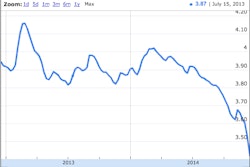
 Click on the image (or here) to take a quick poll to let us know what you think about PTT technology and to see what others think.
Click on the image (or here) to take a quick poll to let us know what you think about PTT technology and to see what others think.Radios have connected dispatchers to drivers since the 1950s, perhaps earlier. From the start, radio communications created the instant “push-to-talk” (PTT) pipeline between the office and mobile workers to update schedules and routes as the day progressed.
In the 1960s, computers merged with radio systems to create an early form of group talk called “trunking” whereby dispatchers could switch from talking to a single driver to a group of drivers or the entire fleet.
One of the biggest advancements to radio systems came in the 1990s with Nextel offering nationwide PTT voice service combined with cellular connectivity for fleets to run a variety of fleet management applications.
In the past decade, most of the major network carriers have created IP-based communications to connect fleets with their mobile workers in an even more efficient way than radio. One of the more recent developments is Web-based software applications that instantly connect the office to drivers using PTT, text and data.
AT&T, for example, offers such an application for its Enhanced PTT service. Its Integrated Dispatch application is uniquely centered on voice communications for fleets that would benefit from having instant, nationwide PTT connectivity with drivers and workers. Fleets that have multiple pickups and deliveries per route, such as couriers, and work fleets like construction or home services would be the most likely users.
AT&T’s dispatch application automatically captures the location of drivers from the built-in GPS feature in smartphones. This eliminates the need for dispatchers to conduct routine check calls. In cases where cellular connectivity is not available, such as inside a building, some phones can also send Enhanced PTT messages through a Wi-Fi connection.
The Integrated Dispatch application lets fleets create groups and subgroups of drivers assigned to each dispatcher. These settings are immediately pushed out to the console of each dispatcher and to the devices in the field.
A dispatcher can initiate a PTT call to an individual driver or to a pre-set group or subgroup of drivers with a mouse click. The application lets dispatchers create an ad-hoc group of drivers, as needed, and save that group for use throughout the day. An ad-hoc group might need to be created for workers assigned to a certain customer for the day, for example.
Users can bundle up to 10 individual members in an ad-hoc group. They can create up to 8 different talk groups at a time.
The dispatch console has an activity queue the dispatcher uses to manage multiple tasks at the same time. If a dispatcher misses an inbound call, for instance, an alert would pop up in the queue. With the click of a mouse the dispatcher could initiate a callback.
The dispatcher can also change his status to “do not disturb” at any time and record incoming calls for later review. Call activity throughout the day can be logged and exported to an Excel file in cases where fleets want to save the data.
Both dispatchers and drivers can utilize the Enhanced PTT feature in a hands-free manner. A foot pedal can be used in the office or in the truck to initiate PTT calls, for example.
The evolution of voice communications from radio to full-featured dispatch applications with IP-based PTT communications shows that the options for talking to drivers is more efficient than ever.
Let us know what you think about the evolution of PTT voice communications. Does the technology seem outdated or is it more applicable now than ever? Click here to take a quick poll and compare your results to others.











